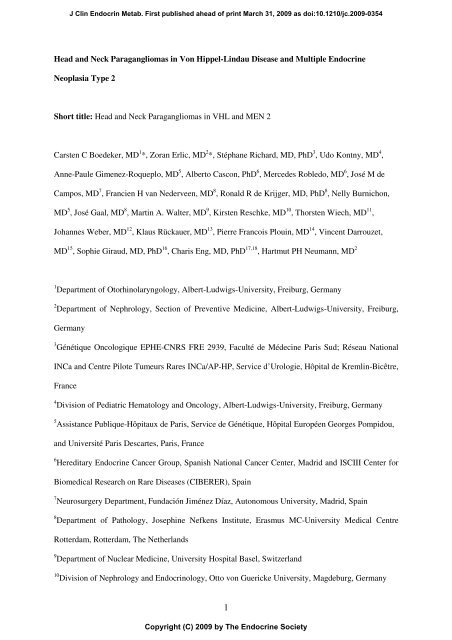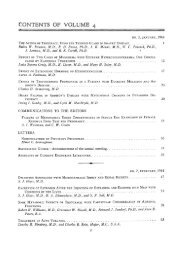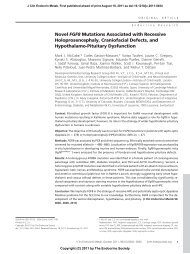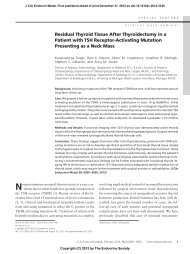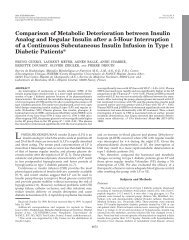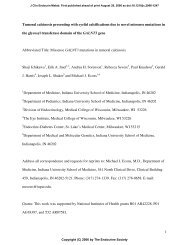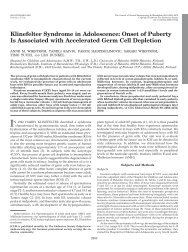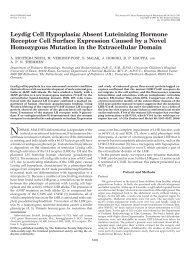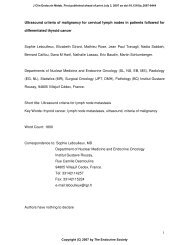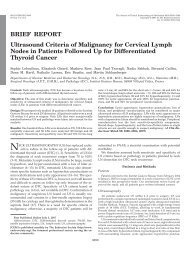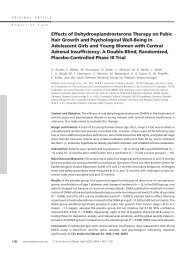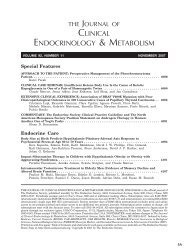Head and Neck Paragangliomas in Von Hippel-Lindau Disease and ...
Head and Neck Paragangliomas in Von Hippel-Lindau Disease and ...
Head and Neck Paragangliomas in Von Hippel-Lindau Disease and ...
You also want an ePaper? Increase the reach of your titles
YUMPU automatically turns print PDFs into web optimized ePapers that Google loves.
<strong>Head</strong> <strong>and</strong> <strong>Neck</strong> <strong>Paragangliomas</strong> <strong>in</strong> <strong>Von</strong> <strong>Hippel</strong>-L<strong>in</strong>dau <strong>Disease</strong> <strong>and</strong> Multiple Endocr<strong>in</strong>e<br />
Neoplasia Type 2<br />
Short title: <strong>Head</strong> <strong>and</strong> <strong>Neck</strong> <strong>Paragangliomas</strong> <strong>in</strong> VHL <strong>and</strong> MEN 2<br />
Carsten C Boedeker, MD 1 *, Zoran Erlic, MD 2 *, Stéphane Richard, MD, PhD 3 , Udo Kontny, MD 4 ,<br />
Anne-Paule Gimenez-Roqueplo, MD 5 , Alberto Cascon, PhD 6 , Mercedes Robledo, MD 6 , José M de<br />
Campos, MD 7 , Francien H van Nederveen, MD 8 , Ronald R de Krijger, MD, PhD 8 , Nelly Burnichon,<br />
MD 5 , José Gaal, MD 8 , Mart<strong>in</strong> A. Walter, MD 9 , Kirsten Reschke, MD 10 , Thorsten Wiech, MD 11 ,<br />
Johannes Weber, MD 12 , Klaus Rückauer, MD 13 , Pierre Francois Plou<strong>in</strong>, MD 14 , V<strong>in</strong>cent Darrouzet,<br />
MD 15 , Sophie Giraud, MD, PhD 16 , Charis Eng, MD, PhD 17,18 , Hartmut PH Neumann, MD 2<br />
1 Department of Otorh<strong>in</strong>olaryngology, Albert-Ludwigs-University, Freiburg, Germany<br />
2 Department of Nephrology, Section of Preventive Medic<strong>in</strong>e, Albert-Ludwigs-University, Freiburg,<br />
Germany<br />
3 Génétique Oncologique EPHE-CNRS FRE 2939, Faculté de Médec<strong>in</strong>e Paris Sud; Réseau National<br />
INCa <strong>and</strong> Centre Pilote Tumeurs Rares INCa/AP-HP, Service d’Urologie, Hôpital de Kreml<strong>in</strong>-Bicêtre,<br />
France<br />
J Cl<strong>in</strong> Endocr<strong>in</strong> Metab. First published ahead of pr<strong>in</strong>t March 31, 2009 as doi:10.1210/jc.2009-0354<br />
4 Division of Pediatric Hematology <strong>and</strong> Oncology, Albert-Ludwigs-University, Freiburg, Germany<br />
5 Assistance Publique-Hôpitaux de Paris, Service de Génétique, Hôpital Européen Georges Pompidou,<br />
<strong>and</strong> Université Paris Descartes, Paris, France<br />
6 Hereditary Endocr<strong>in</strong>e Cancer Group, Spanish National Cancer Center, Madrid <strong>and</strong> ISCIII Center for<br />
Biomedical Research on Rare <strong>Disease</strong>s (CIBERER), Spa<strong>in</strong><br />
7 Neurosurgery Department, Fundación Jiménez Díaz, Autonomous University, Madrid, Spa<strong>in</strong><br />
8 Department of Pathology, Joseph<strong>in</strong>e Nefkens Institute, Erasmus MC-University Medical Centre<br />
Rotterdam, Rotterdam, The Netherl<strong>and</strong>s<br />
9 Department of Nuclear Medic<strong>in</strong>e, University Hospital Basel, Switzerl<strong>and</strong><br />
10 Division of Nephrology <strong>and</strong> Endocr<strong>in</strong>ology, Otto von Guericke University, Magdeburg, Germany<br />
1<br />
Copyright (C) 2009 by The Endocr<strong>in</strong>e Society
11 Department of Pathology, Albert-Ludwigs-University, Freiburg, Germany<br />
12 Department of Neuroradiology, Albert-Ludwigs-University, Freiburg, Germany<br />
13 Department of Surgery, University of Freiburg, Germany<br />
14 Assistance Publique-Hôpitaux de Paris, Unité d'Hypertension artérielle, Hôpital Européen Georges<br />
Pompidou, <strong>and</strong> Université Paris Descartes, Paris, France<br />
15 ENT Department, Skull Base Surgery Department, Hôpital Pellegr<strong>in</strong>, University Victor Segalen<br />
Bordeaux 2, Bordeaux, France 33000F<br />
16 Laboratoire de Génétique & Réseau National INCa, Hôpital Edouard Herriot, Lyon, France<br />
17 Genomic Medic<strong>in</strong>e Institute, Lerner Research Institute, Clevel<strong>and</strong> Cl<strong>in</strong>ic, Clevel<strong>and</strong>, OH<br />
18 Taussig Cancer Institute, Clevel<strong>and</strong> Cl<strong>in</strong>ic, Clevel<strong>and</strong>, OH<br />
*These authors contributed equally to the study.<br />
Correspondence<br />
Prof. Dr. Hartmut P.H. Neumann, MD<br />
Department of Nephrology <strong>and</strong> General Medic<strong>in</strong>e, University of Freiburg<br />
Hugstetter Str. 55, D-79106 Freiburg, Germany<br />
phone: +49-761/270-3363, fax: +49-761/270-3778<br />
e-mail: hartmut.neumann @unikl<strong>in</strong>ik-freiburg.de<br />
Disclosure summary: The authors have noth<strong>in</strong>g to disclose.<br />
NIH Statement: "This is an un-copyedited author manuscript copyrighted by The Endocr<strong>in</strong>e Society.<br />
This may not be duplicated or reproduced, other than for personal use or with<strong>in</strong> the rule of “Fair Use<br />
of Copyrighted Materials” (section 107, Title 17, U.S. Code) without permission of the copyright<br />
owner, The Endocr<strong>in</strong>e Society. From the time of acceptance follow<strong>in</strong>g peer review, the full text of this<br />
manuscript is made freely available by The Endocr<strong>in</strong>e Society at http://www.endojournals.org/. The<br />
f<strong>in</strong>al copy edited article can be found at http://www.endojournals.org/. The Endocr<strong>in</strong>e Society<br />
2
disclaims any responsibility or liability for errors or omissions <strong>in</strong> this version of the manuscript or <strong>in</strong><br />
any version derived from it by the National Institutes of Health or other parties. The citation of this<br />
article must <strong>in</strong>clude the follow<strong>in</strong>g <strong>in</strong>formation: author(s), article title, journal title, year of publication<br />
<strong>and</strong> DOI.”<br />
Precise: <strong>Head</strong> <strong>and</strong> neck paragangliomas represent a very rare feature <strong>in</strong> von <strong>Hippel</strong>-L<strong>in</strong>dau<br />
disease, multiple endocr<strong>in</strong>e neoplasia type 2 <strong>and</strong> neurofibromatosis type 1.<br />
Key words: <strong>Head</strong> <strong>and</strong> neck paraganglioma, paraganglioma syndromes, pheochromocytoma, von<br />
<strong>Hippel</strong>-L<strong>in</strong>dau disease, multiple endocr<strong>in</strong>e neoplasia type 2, neurofibromatosis type 1, germl<strong>in</strong>e<br />
mutations<br />
Word count: Manuscript Text 3535; Abstract 249; Number of Tables: 1.<br />
Repr<strong>in</strong>t requests should be addressed Prof. Dr. Hartmut P.H. Neumann, MD<br />
Sources of fund<strong>in</strong>g <strong>and</strong> support:<br />
Hartmut P.H. Neumann is supported by grants from the Deutsche Krebshilfe (107995 to HPHN), the<br />
Deutsche Forschungsgeme<strong>in</strong>schaft (NE 571/5-3 to HPHN), <strong>and</strong> the European Union (LSHC-CT-2005-<br />
518200 to HPHN).<br />
Anne-Paule Gimenez-Roqueplo is supported by Institut National de la Santé et de la Recherche<br />
Médicale, by PHRC grant COMETE 3 for the COMETE Network (AOM 06 179) <strong>and</strong> by GIS-<br />
Maladies Rares for the PGL.NET network.<br />
Mercedes Robledo is supported by a grant from FIS (PI080883) <strong>and</strong> CIBERER.<br />
Stéphane Richard <strong>and</strong> Sophie Giraud are supported by grants from the Institut National du Cancer<br />
(INCa) <strong>and</strong> the Ligue Nationale contre le Cancer (Comités du Cher et de l’Indre).<br />
3
Charis Eng is the recipient of a Doris Duke Dist<strong>in</strong>guished Cl<strong>in</strong>ical Scientist Award, is the Sondra J.<br />
<strong>and</strong> Stephen R. Hardis Endowed Chair of Cancer Genomic Medic<strong>in</strong>e at the Clevel<strong>and</strong> Cl<strong>in</strong>ic <strong>and</strong> is a<br />
NIH funded <strong>in</strong>vestigator.<br />
Francien van Nederveen is supported by a grant from The Netherl<strong>and</strong>s Organisation for Health<br />
Research <strong>and</strong> Development <strong>and</strong> The Dutch Cancer Society.<br />
Ronald de Krijger is supported by a grant from the “V<strong>and</strong>eres” Foundation.<br />
4
ABSTRACT<br />
Background<br />
<strong>Head</strong> <strong>and</strong> neck paragangliomas (HNPs) occur as sporadic or familial entities, the latter mostly <strong>in</strong><br />
association with germl<strong>in</strong>e mutations of the SDHB, SDHC or SDHD (SDHx) genes. Heritable non-<br />
SDHx HNP might occur <strong>in</strong> von <strong>Hippel</strong>-L<strong>in</strong>dau disease (VHL, VHL gene), multiple endocr<strong>in</strong>e<br />
neoplasia type 2 (MEN2, RET gene) <strong>and</strong> neurofibromatosis type 1 (NF1, NF1 gene). Reports of non-<br />
SDHx HNP presentations are scarce <strong>and</strong> guidance for genetic test<strong>in</strong>g non-existent.<br />
Material <strong>and</strong> Methods<br />
An <strong>in</strong>ternational consortium registered patients with HNPs <strong>and</strong> performed mutation analyses of the<br />
SDHx, VHL <strong>and</strong> RET genes. Those with SDHx germl<strong>in</strong>e mutations were excluded for purposes of this<br />
study. Personal <strong>and</strong> family histories were evaluated for paraganglial tumors, for the major tumor<br />
manifestations <strong>and</strong> for family history of VHL, MEN2 or NF1.<br />
Results<br />
Twelve patients were found to have hereditary non-SDHx HNPs out of a total of 809 HNP <strong>and</strong> 2084<br />
VHL registrants, 11 <strong>in</strong> the sett<strong>in</strong>g of germl<strong>in</strong>e VHL mutations <strong>and</strong> 1 of a RET mutation. The<br />
prevalence of hereditary HNP is 5/1,000 VHL patients <strong>and</strong> 9/1,000 non-SDHx HNP patients.<br />
Comprehensive literature review revealed previous reports of HNPs <strong>in</strong> 5 VHL, 2 MEN2 <strong>and</strong> <strong>in</strong> 1 NF1<br />
patients. Overall, 11 here presented HNP cases <strong>and</strong> 4 previously reported VHL-HNPs had lesions<br />
characteristic for VHL <strong>and</strong>/or a positive family history for VHL.<br />
Conclusions<br />
Our observations provide evidence that molecular genetic test<strong>in</strong>g for VHL or RET germl<strong>in</strong>e mutations<br />
<strong>in</strong> patients with HNP should only be done, if personal <strong>and</strong>/or family history shows evidence for one of<br />
these syndromes.<br />
5
INTRODUCTION<br />
<strong>Head</strong> <strong>and</strong> neck paragangliomas (HNPs) are highly vascularized tumors of the autonomic nervous<br />
system, ma<strong>in</strong>ly aris<strong>in</strong>g from the carotid body or the glomus jugulare, tympanicum or vagale. HNPs<br />
occur as sporadic as well as hereditary entities (1, 2). Hereditary HNPs have attracted <strong>in</strong>terest <strong>in</strong><br />
particular from 2000, when a first susceptibility gene for the so called ”paraganglioma syndromes”<br />
(PGL) was detected (PGL 1) (3). This gene, SDHD, located on 11q23, encodes subunit D of the<br />
enzyme succ<strong>in</strong>ate dehydrogenase or mitochondrial complex II. Subsequently, two other PGL<br />
susceptibility genes, encod<strong>in</strong>g the B <strong>and</strong> C subunits of SDH, were described, SDHB (PGL4) <strong>and</strong><br />
SDHC (PGL3) (4, 5). A fourth susceptibility gene, for PGL 2, has been mapped to 11q13, but has not<br />
yet been identified (6). These three known PGL susceptibility genes will be collectively referred to<br />
here as SDHx. In contrast, SDHA gene mutations do not predispose to PGL (7).<br />
Because of <strong>in</strong>tense cl<strong>in</strong>ical <strong>in</strong>vestigation subsequent to 2000, we know that HNP is a major component<br />
tumor of the syndromes characterized by germl<strong>in</strong>e SDHx mutations (1, 2, 8, 9). Studies from us <strong>and</strong><br />
others have shown that patients with SDHx mutations are not only at risk for HNPs, but also for other<br />
tumors of the paraganglial system <strong>in</strong>clud<strong>in</strong>g adrenal pheochromocytoma <strong>and</strong> extraadrenal<br />
pheochromocytoma of the retroperitoneum, pelvis <strong>and</strong> thorax (1, 2, 8, 10, 11). However, HNPs<br />
occurr<strong>in</strong>g <strong>in</strong> the non-SDHx heritable disorders have been anecdotal. In order to exam<strong>in</strong>e the cl<strong>in</strong>ical<br />
context of non-SDHx heritable HNPs, we adopted <strong>and</strong> updated the European Australian American<br />
HNP Registry <strong>in</strong> which we previously studied the characteristics <strong>and</strong> prevalence of HNPs (12) <strong>and</strong><br />
proposed to different groups to jo<strong>in</strong> us. As the Non-SDHx HNP Consortium, we then proceeded to<br />
study the prevalence of HNPs <strong>and</strong> other salient cl<strong>in</strong>ical features <strong>and</strong> family histories <strong>in</strong> registrants<br />
found to have von <strong>Hippel</strong>-L<strong>in</strong>dau disease (VHL), multiple endocr<strong>in</strong>e neoplasia type 2 (MEN 2) <strong>and</strong><br />
type 1 neurofibromatosis (NF 1).<br />
6
MATERIAL AND METHODS<br />
Subjects<br />
The <strong>in</strong>ternational Non-SDHx-HNP-Consortium was constituted <strong>in</strong> 2008 <strong>in</strong> order to identify <strong>and</strong> to<br />
cl<strong>in</strong>ically <strong>and</strong> genetically characterize patients with HNP with heritable syndromes <strong>in</strong> the absence of<br />
germl<strong>in</strong>e SDHx mutations. We paid particular attention to additional component tumors suggestive of<br />
VHL, MEN 2 or NF 1. We adopted <strong>and</strong> updated the registrants from the European Australian<br />
American HNP Registry <strong>in</strong>clud<strong>in</strong>g symptomatic <strong>and</strong> asymptomatic HNPs as of March 1, 2009 which<br />
<strong>in</strong>cluded a total of 513 subjects. In particular, centers dedicated to cl<strong>in</strong>ical care <strong>and</strong> molecular genetic<br />
diagnosis of HNPs <strong>in</strong> 26 countries <strong>in</strong>clud<strong>in</strong>g Germany, Spa<strong>in</strong>, The Netherl<strong>and</strong>s, Italy, Hungary,<br />
Ukra<strong>in</strong>e, Serbia, Greece, Pol<strong>and</strong>, Sweden, F<strong>in</strong>l<strong>and</strong>, Denmark, Belgium, France, Switzerl<strong>and</strong>, Austria,<br />
Turkey, Iran, Ch<strong>in</strong>a, Japan, the USA, Brazil, Chile, Argent<strong>in</strong>a, Australia <strong>and</strong> New Zeal<strong>and</strong> were<br />
recontacted. Separately to the European Australian American HNP Registry, the Netherl<strong>and</strong>s <strong>and</strong><br />
France have national HNP registries with 147 <strong>and</strong> 149 registrants <strong>in</strong> whom SDHx mutations have been<br />
excluded, respectively. This aimed to identify unrecognized patients with HNP for case registration<br />
<strong>and</strong> for updat<strong>in</strong>g the HNP registry for prevalence estimations.<br />
For prevalence estimations <strong>in</strong> VHL, we used the national population-based registries for Germany,<br />
France, Spa<strong>in</strong>, <strong>and</strong> the Netherl<strong>and</strong>s.<br />
Genetic Analysis<br />
All registrants provided 10 ml EDTA-anticoagulated blood for molecular genetic analyses. The<br />
analyses comprised test<strong>in</strong>g of the VHL (RefSeq:NM_000551.2) <strong>and</strong> RET (RefSeq:NM_020975.4)<br />
genes for germl<strong>in</strong>e mutations. DNA extraction, primers, PCR conditions <strong>and</strong> sequenc<strong>in</strong>g methods<br />
followed published protocols of <strong>in</strong>ternational st<strong>and</strong>ards (1, 2, 10, 11). Of note, analyses also <strong>in</strong>cluded<br />
screen<strong>in</strong>g for large deletions or rearrangements of the VHL gene, s<strong>in</strong>ce such mutations have been<br />
described <strong>in</strong> VHL patients with pheochromocytoma (13, 14). Overall, 809 HNP patients<br />
(513+147+149) of the European Australian American HNP Registry, the French HNP Registry <strong>and</strong><br />
the Rotterdam HNP Registry comb<strong>in</strong>ed were subjected to the above described analyses.<br />
7
Criteria for Diagnosis of Non-SDHx Heritable Neoplasia Syndromes<br />
The criteria for non-SDHx heritable HNPs are absence of germl<strong>in</strong>e mutations <strong>in</strong> the genes SDHB,<br />
SDHC <strong>and</strong> SDHC analyzed as shown above <strong>and</strong> presence of cl<strong>in</strong>ical or molecular genetic evidence for<br />
MEN 2, VHL or NF 1. VHL was diagnosed, if the patient was found to have a germl<strong>in</strong>e VHL mutation<br />
<strong>and</strong>/or had at least one of the tumors of the VHL component spectrum of hemangioblastoma of the eye<br />
or central nervous system (CNS), renal cell carc<strong>in</strong>oma (RCC) or pheochromocytoma. MEN 2 was<br />
diagnosed if the patient was found to carry a germl<strong>in</strong>e RET mutation or a first degree relative had a<br />
medullary thyroid carc<strong>in</strong>oma <strong>and</strong> a pheochromocytoma. NF 1 was diagnosed, if the patient had at least<br />
two of the follow<strong>in</strong>g cl<strong>in</strong>ical features: multiple neurofibromas, plexiform neurofibroma, axillary<br />
freckl<strong>in</strong>g, café au lait spots <strong>and</strong> Lisch nodules of the iris <strong>and</strong>/or a first degree relative with confirmed<br />
NF 1 (8, 15-17).<br />
Approval <strong>and</strong> Consent<br />
The study design was approved by the ethical committee of the University of Freiburg <strong>and</strong> all<br />
participat<strong>in</strong>g centers accord<strong>in</strong>gly. All participants gave written <strong>in</strong>formed consent. The study was<br />
performed <strong>in</strong> accordance with the guidel<strong>in</strong>es of the Hels<strong>in</strong>ki Declaration of 1975, as revised <strong>in</strong> 1983.<br />
RESULTS<br />
By March 1, 2009, the International Non-SDHx HNP Consortium registered 12 patients with HNPs<br />
who showed characteristics suggest<strong>in</strong>g a non-SDHx-related heritable tumor syndrome. Eleven of the<br />
12 patients were found to carry germl<strong>in</strong>e mutations <strong>in</strong> the VHL gene, <strong>and</strong> one <strong>in</strong> the RET gene. Six of<br />
the patients orig<strong>in</strong>ate from France, two from Germany, two from Spa<strong>in</strong> <strong>and</strong> one each from The<br />
Netherl<strong>and</strong>s <strong>and</strong> Switzerl<strong>and</strong>.<br />
To estimate the prevalence of HNP <strong>in</strong> VHL <strong>in</strong>dividuals, we used the country-specific registries to<br />
provide a denom<strong>in</strong>ator. For VHL, the French VHL registry comprises 886 registrants, the German<br />
VHL Registry based <strong>in</strong> Freiburg 844, the Spanish VHL registry 296, <strong>and</strong> the Dutch VHL registry 58<br />
registrants respectively as of January 1, 2009.<br />
8
Regard<strong>in</strong>g VHL, the prevalence of HNP <strong>in</strong> the national registries was 2/844 or 2/1,000 <strong>in</strong> Germany,<br />
2/296 or 7/1,000 <strong>in</strong> Spa<strong>in</strong>, <strong>and</strong> 6/886 or 7/1,000 <strong>in</strong> France, respectively. In the Netherl<strong>and</strong>s, the VHL<br />
registry comprises 58 cases, but none of the registrants had HNP (18). In total, prevalence of HNP<br />
amongst VHL cases was 10/2085 or 5/1,000.<br />
Regard<strong>in</strong>g HNP, the European Australian American <strong>Head</strong> <strong>and</strong> <strong>Neck</strong> Paraganglioma Registry counts<br />
513 registrants, the Rotterdam HNP registry 147 registrants <strong>and</strong> the French HNP registry 149<br />
registrants <strong>in</strong> whom SDHx mutations have been excluded.<br />
Regard<strong>in</strong>g HNP prevalence <strong>in</strong> the European Australian American HNP Registry, which <strong>in</strong>cludes<br />
Germany, Spa<strong>in</strong> <strong>and</strong> Switzerl<strong>and</strong> among other countries but not the Netherl<strong>and</strong>s <strong>and</strong> France, was<br />
5/513 or 10/1,000 registrants <strong>in</strong> whom SDHx mutations have been excluded. In the Netherl<strong>and</strong>s <strong>and</strong><br />
France, the prevalence of hereditary non-SDHx HNP was 1/147 or 7/1,000 <strong>and</strong> 1/149 or 7/1,000,<br />
respectively. In total, among all 809 registrants, prevalence was 9/1,000.<br />
Case reports:<br />
Case 1<br />
In 1997, a 7-year old boy was diagnosed with a malignant extraadrenal pheochromocytoma of the left<br />
retroperitoneum with regional lymph node metastases. These were treated with resection of the<br />
primary tumor, lymphadenectomy <strong>and</strong> chemotherapy accord<strong>in</strong>g to the protocol GPOH-MET 97 (19).<br />
At age 9, there was a local recurrence, which was treated with resection <strong>and</strong> external radiotherapy of<br />
20 Gy. At age 13, a right adrenal pheochromocytoma was resected. At age 15, a left carotid body<br />
tumor was cl<strong>in</strong>ically detected <strong>and</strong> removed, but this recurred at age 16 <strong>and</strong> aga<strong>in</strong> resected. At age 17, a<br />
pheochromocytoma at the renal pelvis was diagnosed on a rout<strong>in</strong>e MRI <strong>and</strong> resected. At age 18, he is<br />
disease-free except for a lesion <strong>in</strong> the L1 vertebral body suggestive of hemangioma or<br />
pheochromocytoma, a lesion first diagnosed <strong>in</strong> 2004 but unchanged over the last 5 years. The family<br />
history was <strong>in</strong>itially negative for VHL. Molecular genetic test<strong>in</strong>g revealed the mutation VHL<br />
p.Tyr98His. Predictive test<strong>in</strong>g was offered to the patient’s family <strong>and</strong> revealed that the mother <strong>and</strong><br />
other relatives were positive. Cl<strong>in</strong>ical <strong>in</strong>vestigations of these relatives showed ret<strong>in</strong>al<br />
9
hemangioblastomas <strong>in</strong> the aunt <strong>and</strong> a pheochromocytoma <strong>in</strong> a cous<strong>in</strong> whereas the mother had no<br />
abnormalities at all.<br />
Case 2<br />
An asymptomatic 29-year old man was offered VHL-specific cl<strong>in</strong>ical surveillance due to a family<br />
history of known VHL <strong>and</strong> genetic test<strong>in</strong>g which revealed carriership for the family-specific VHL<br />
mutation. MRI of the bra<strong>in</strong> showed surpris<strong>in</strong>gly a pituitary tumor. Further work up showed<br />
hyperprolact<strong>in</strong>emia <strong>and</strong> thus biochemical evidence for a prolact<strong>in</strong>oma. He was treated with<br />
bromocript<strong>in</strong>e for five years. At age 34, he reported a pa<strong>in</strong>ful swell<strong>in</strong>g on his left neck where a mass<br />
was palpable. CT disclosed a left carotid body tumor which was resected. At age 41, multiple<br />
pancreatic cysts <strong>and</strong> a left kidney cancer were detected which was resected <strong>and</strong> showed histologically<br />
a clear cell carc<strong>in</strong>oma. The father <strong>and</strong> two brothers have been treated for multiple ret<strong>in</strong>al, cerebellar<br />
<strong>and</strong> sp<strong>in</strong>al cord hemangioblastomas. Molecular genetic test<strong>in</strong>g of the patient detected the family-<br />
specific VHL mutation p.Leu135X.<br />
Case 3<br />
A 23-year old female was <strong>in</strong>itially diagnosed with hypertension <strong>and</strong> elevated platelets. Because of the<br />
young age <strong>and</strong> hypertension, 24-hour ur<strong>in</strong>e catecholam<strong>in</strong>es were measured <strong>and</strong> found to be elevated.<br />
Abdom<strong>in</strong>al CT scan disclosed bilateral adrenal pheochromocytomas, confirmed by 123-iod<strong>in</strong>e-MIBG<br />
sc<strong>in</strong>tigraphy. The MIBG scan, however, did not only show uptake <strong>in</strong> the adrenal gl<strong>and</strong>s, but also <strong>in</strong> the<br />
right neck area. Subsequently, an MRI of the neck disclosed a 2.5 cm carotid body tumor. The tumor<br />
was resected <strong>and</strong> histologically confirmed. The family history was negative for tumors of the VHL<br />
spectrum. Genetic test<strong>in</strong>g revealed a germl<strong>in</strong>e mutation of the VHL gene p.Phe119Leu.<br />
Case 4<br />
A 23-year old asymptomatic female presented with a palpable mass on the left side of the neck dur<strong>in</strong>g<br />
a rout<strong>in</strong>e check-up for her VHL p.Arg64Pro family-specific mutation, already previously identified <strong>in</strong><br />
this patient’s family. No other cl<strong>in</strong>ical manifestations had been detected until then. Somatostat<strong>in</strong><br />
10
eceptor sc<strong>in</strong>tigraphy revealed a hotspot near the left carotid artery, <strong>in</strong>dicat<strong>in</strong>g a paraganglioma. No<br />
hypertension or <strong>in</strong>crease <strong>in</strong> catecholam<strong>in</strong>es was observed. The removed 2.5 cm tumor was<br />
histopathologically a paraganglioma. At age 33, there was no recurrence, nor did the patient have other<br />
tumors. Interest<strong>in</strong>gly, the VHL disease had a heterogeneous presentation <strong>in</strong> the family, with bilateral<br />
pheochromocytomas <strong>and</strong> clear cell renal carc<strong>in</strong>oma as the <strong>in</strong>itial presentation <strong>in</strong> the father. In addition,<br />
the patient´s son underwent a unilateral adrenalectomy for pheochromocytoma at age of 7.<br />
Case 5<br />
A 37-year old female noticed a mass at the left side of her neck. MRI disclosed a 3 cm carotid body<br />
tumor. The mass was removed, <strong>and</strong> histopathology revealed a paraganglioma. At age 50, the patient<br />
was operated for a left adrenal pheochromocytoma. Cl<strong>in</strong>ical screen<strong>in</strong>g for VHL showed asymptomatic<br />
ret<strong>in</strong>al <strong>and</strong> sp<strong>in</strong>al hemangioblastomas. Her mother suffered from bl<strong>in</strong>dness of one eye potentially due<br />
to ret<strong>in</strong>al angiomatosis <strong>and</strong> was operated for a left adrenal pheochromocytoma. Her uncle died due to<br />
renal cell carc<strong>in</strong>oma <strong>and</strong> had sp<strong>in</strong>al hemangioblastomas. Molecular genetic analysis revealed the<br />
mutation VHL p.Arg107His. All her three sons are also carriers, one of whom was operated for a right<br />
adrenal pheochromocytoma at age 24 <strong>and</strong> a left adrenal pheochromocytoma at age 32. Screen<strong>in</strong>g of<br />
the 27-year old son revealed asymptomatic ret<strong>in</strong>al <strong>and</strong> sp<strong>in</strong>al hemangioblastomas.<br />
Case 6<br />
A 42-year old male with a history of thyroidectomy for medullary thyroid carc<strong>in</strong>oma <strong>and</strong> removal of<br />
an adrenal cortical adenoma (not pheochromocytoma) presented with chronic headaches, t<strong>in</strong>nitus <strong>and</strong><br />
progressive hear<strong>in</strong>g loss. Diagnostic whole-body work-up revealed a 4 cm jugular paraganglioma with<br />
partial destruction of the labyr<strong>in</strong>th <strong>and</strong> without further tumor manifestations. The jugular tumor was<br />
treated with selective arterial embolization <strong>and</strong> stereotactic external-beam radiation. Dur<strong>in</strong>g follow-up,<br />
new metastases from the medullary thyroid carc<strong>in</strong>oma were diagnosed <strong>and</strong> the patient was transferred<br />
for systemic radio-peptide treatment with DOTATOC. Both malignancies showed dist<strong>in</strong>ct radiotracer<br />
uptake <strong>and</strong> the treatment resulted <strong>in</strong> partial response. Molecular genetic analysis revealed a<br />
p.Cys620Arg RET mutation.<br />
11
Case 7<br />
In 1980, a 15-year old girl with a familial history of VHL presented with loss of visual acuity lead<strong>in</strong>g<br />
to the diagnosis of bilateral ret<strong>in</strong>al hemangioblastomas followed by laser <strong>and</strong> cryotherapy. However,<br />
outcome was unilateral bl<strong>in</strong>dness. Further, the patient was then operated three times for CNS<br />
hemangioblastomas between age 18 <strong>and</strong> 24. At age 26 she presented with a palpable lateral neck mass.<br />
CT of the head <strong>and</strong> neck revealed a 3 cm carotid body tumor. The tumor was removed, <strong>and</strong> histology<br />
showed a paraganglioma. Molecular genetics identified the VHL germl<strong>in</strong>e mutation p.Thr105Pro.<br />
Case 8<br />
In 1997, a 19-year old man with a familial history for VHL presented with headaches. MRI of the<br />
CNS was normal, but ophthalmologic exam<strong>in</strong>ation showed a right ret<strong>in</strong>al hemangioblastoma that was<br />
treated by laser. In 2002, he had right nephrectomy <strong>and</strong> left nephron-spar<strong>in</strong>g surgery for renal cell<br />
carc<strong>in</strong>oma. At age 27, a palpable mass on the left side of the neck was diagnosed dur<strong>in</strong>g dental care.<br />
CT <strong>and</strong> MRI revealed a 4 cm carotid body tumor which was removed after selective embolization.<br />
Histology revealed a paraganglioma. The patient has also pancreatic cysts. Molecular genetics<br />
identified the deletion of exons 2 <strong>and</strong> 3 of the VHL gene.<br />
Case 9<br />
In 1990, a 26-year old woman from a VHL family presented with lumbar pa<strong>in</strong>. CT showed a right<br />
adrenal pheochromocytoma which was removed. Two years later she had left nephrectomy for<br />
multiple renal cell carc<strong>in</strong>oma. At age 33, she presented with a lateral cervical mass associated with<br />
Horner’s syndrome <strong>and</strong> pa<strong>in</strong> <strong>in</strong> the right ear. CT showed a 6 cm carotid paraganglioma which was<br />
removed <strong>and</strong> histologically confirmed. At age 42 a cerebellar hemangioblastoma was removed.<br />
Molecular analysis identified the VHL germl<strong>in</strong>e mutation p.Ser139fs.<br />
Case 10<br />
12
In 1994, a 34-year old woman without personal <strong>and</strong> familial history for VHL was referred to the<br />
hospital because of persistent pharyngeal discomfort. MRI demonstrated a 4 cm tumor <strong>in</strong> the<br />
parapharyngeal space suggestive of a schwannoma or a carotid paraganglioma. The tumor was<br />
removed <strong>and</strong> histology revealed a paraganglioma. Postoperatively, she had Horner’s syndrome <strong>and</strong> a<br />
transitory hypoglossal paresis. At age 46, bilateral adrenal pheochromocytoma <strong>and</strong> a paraaortic<br />
paraganglioma were removed. Later, her niece has been diagnosed with a pheochromocytoma, <strong>and</strong> her<br />
brother suffered from pheochromocytoma, renal cell carc<strong>in</strong>oma <strong>and</strong> ret<strong>in</strong>al hemangioblastomas. The<br />
prob<strong>and</strong>’s mother was then found to have pheochromocytoma. Molecular analysis identified the VHL<br />
mutation p.Tyr98His.<br />
Case 11<br />
In 1978, an 8-year old girl without familial history of VHL was operated for a right<br />
pheochromocytoma, <strong>and</strong> at age 13, for a contralateral pheochromocytoma. At age 15, a 4 cm mass at<br />
the neck was diagnosed by selective arteriography as a carotid paraganglioma which was removed <strong>and</strong><br />
histologically confirmed. The patient was then operated twice for cerebellar hemangioblastoma at age<br />
22, lead<strong>in</strong>g to the diagnosis of VHL disease. At age 27, the patient was operated aga<strong>in</strong> for a retrocaval<br />
pheochromocytoma <strong>and</strong> for islet cell tumors. The patient was also repeatedly treated for bilateral<br />
ret<strong>in</strong>al hemangioblastomas lead<strong>in</strong>g to bl<strong>in</strong>dness at age 32. At age 36, aga<strong>in</strong> a pheochromocytoma was<br />
removed. Molecular genetic analysis identified the p.Thr157Ile VHL germl<strong>in</strong>e mutation. So far, there<br />
are no affected relatives.<br />
Case 12<br />
In 1993, a 39-year old female with recent onset of hypertension was diagnosed with a right<br />
pheochromocytoma. At age 36, a suspected left pheochromocytoma was noted by CT <strong>and</strong> <strong>in</strong>creased<br />
ur<strong>in</strong>ary metanephr<strong>in</strong>es was confirmed at age 39 by 123 iod<strong>in</strong>e MIBG sc<strong>in</strong>tigraphy. This imag<strong>in</strong>g<br />
showed <strong>in</strong> addition an uptake located <strong>in</strong> the neck. MRI confirmed a left adrenal tumor <strong>and</strong> a left 2 cm<br />
vagal paraganglioma which was removed <strong>and</strong> confirmed histopathologically. Genetic test<strong>in</strong>g identified<br />
the VHL p.Tyr156Cys mutation. No other tumor of the VHL spectrum was discovered. Three of her<br />
13
four sons were found to carry the mutation. Cl<strong>in</strong>ical screen<strong>in</strong>g of all 3 disclosed a 2.4 cm abdom<strong>in</strong>al<br />
paraganglioma <strong>in</strong> one of them, but no lesion <strong>in</strong> the other brothers.<br />
Summary of Case Reports<br />
In summary, of the 12 non-SDHx HNP aris<strong>in</strong>g <strong>in</strong> VHL <strong>and</strong> MEN 2 patients, 8 are female <strong>and</strong> 4 are<br />
male, with ages at diagnosis 15-42 (mean 28). Eleven had an VHL mutations <strong>and</strong> one an RET<br />
mutations. Eight of the 11 VHL mutations <strong>and</strong> also the RET mutation were missense mutations. Three<br />
cases were identified at an asymptomatic stage, whereas n<strong>in</strong>e had symptoms of a local mass or due to<br />
dysfunction of the vestibular-cochlear nerve. All but one of the VHL cases had carotid body tumors.<br />
The other VHL case had a vagal paraganglioma <strong>and</strong> the case with the RET mutation had a jugular<br />
paraganglioma. All cases had a s<strong>in</strong>gle HNP. Family history was suggestive for VHL <strong>in</strong> 6 cases.<br />
Additional tumors have been previously diagnosed <strong>in</strong> 8 cases. Thus, all cases with VHL had cl<strong>in</strong>ical<br />
manifestations <strong>and</strong>/or a suggestive family history for VHL.<br />
In addition to those meet<strong>in</strong>g the criteria for heritable non-SDHx-HNP for this study, there are 31 out of<br />
809 registrants who have the stigmata of <strong>in</strong>herited HNP. Eight had a family history for paraganglial<br />
tumors <strong>in</strong> relatives, <strong>and</strong> 5 HNP patients also had abdom<strong>in</strong>al paraganglial tumors. Furthermore is note<br />
worthy that 20 of the HNP patients had multiple tumors. All these patients had no germl<strong>in</strong>e mutation<br />
<strong>in</strong> the genes SDHB, SDHC, SDHD, RET <strong>and</strong> VHL, <strong>and</strong> no cl<strong>in</strong>ical signs for NF1.<br />
DISCUSSION<br />
Paraganglial tumors can be divided <strong>in</strong>to nearly always vasoactive abdom<strong>in</strong>al, pelvic <strong>and</strong> thoracic<br />
pheochromocytomas (here all classified as pheochromocytomas) <strong>and</strong> nearly always non-vasoactive but<br />
space-occupy<strong>in</strong>g tumors of the head <strong>and</strong> neck paraganglia (here all classified as paragangliomas or<br />
HNPs). Several studies over the last 7 years have shown that approximately one third of symptomatic<br />
presentations of pheochromocytomas, even <strong>in</strong> the absence of other syndromic features or family<br />
history, are caused by germl<strong>in</strong>e mutations.(1, 2, 8, 10, 11, 16) The prevalence of susceptibility genes<br />
14
<strong>in</strong>volved <strong>in</strong> a pheochromocytoma presentation, <strong>in</strong> decreas<strong>in</strong>g order of frequency, of VHL, SDHB, RET,<br />
NF1 <strong>and</strong> SDHD is 41%, 18%, 17%, 13%, <strong>and</strong> 11% respectively.(16) Given the data that even<br />
apparently sporadic pheochromocytomas have a relatively high frequency of germl<strong>in</strong>e mutations, most<br />
cl<strong>in</strong>icians would offer gene test<strong>in</strong>g, <strong>in</strong> the sett<strong>in</strong>g of genetic counsell<strong>in</strong>g, to all patients present<strong>in</strong>g with<br />
a pheochromocytoma irrespective of other features or family history. Knowledge of the relative<br />
prevalence of a specific gene <strong>in</strong>volved associated with certa<strong>in</strong> cl<strong>in</strong>ical features allows some type of<br />
prioritisation of which gene(s) to beg<strong>in</strong> test<strong>in</strong>g with. In contrast to relatively high prevalences of VHL,<br />
RET <strong>and</strong> NF1 <strong>in</strong>volved <strong>in</strong> pheochromocytoma presentations, our recent <strong>in</strong>ternational molecular genetic<br />
study on nearly 600 unrelated patients with symptomatic HNPs showed that virtually all patients with<br />
HNPs due to germl<strong>in</strong>e mutations have the mutation <strong>in</strong> one of the follow<strong>in</strong>g genes: SDHB, SDHC <strong>and</strong><br />
SDHD (12). Additionally, certa<strong>in</strong> cl<strong>in</strong>ical features <strong>in</strong> HNP patients can accurately help prioritize which<br />
gene to beg<strong>in</strong> test<strong>in</strong>g (12). The occurrence of HNP <strong>in</strong> the non-SDHx PGL syndromes, ma<strong>in</strong>ly VHL <strong>and</strong><br />
MEN 2, has been anecdotal (20-27). The literature provides little guidance as to the prevalence of<br />
VHL, MEN 2 <strong>and</strong> NF 1 <strong>in</strong> HNP presentations. It also provides little guidance <strong>in</strong> regard to associated<br />
cl<strong>in</strong>ical features <strong>and</strong> family history <strong>in</strong> patients with non-SDHx-related heritable HNP.<br />
Our present study addresses these issues relevant to cl<strong>in</strong>ical practice <strong>in</strong> several subspecialties. First,<br />
among all symptomatic HNP presentations, we were able, after exclusion of SDHx germl<strong>in</strong>e mutation-<br />
associated cases, to estimate that 5/1,000 actually have VHL. Second, we could estimate that among<br />
<strong>in</strong>dividuals with VHL, 8/1,000 will have HNP. Third, VHL has the highest prevalence among non-<br />
SDHx hereditary HNP with 11 out of 12 cases <strong>in</strong> our study. In the literature, 5 of 8 cases had VHL,<br />
<strong>and</strong> 2 had MEN 2 (20-25, 27). All but three VHL patients showed germl<strong>in</strong>e VHL missense mutations.<br />
NF 1 was the etiology of non SDHx heritable HNP <strong>in</strong> one case <strong>in</strong> the literature, but not <strong>in</strong> our series<br />
(26).<br />
Sixteen out of 20 patients, 10 from our study <strong>and</strong> 6 <strong>in</strong> the literature, presented with a carotid body<br />
tumor (20-23, 25, 27). One of our patients <strong>and</strong> one from literature had a glomus jugulare, one of our<br />
patients a glomus vagale tumor <strong>and</strong> one from the literature a glomus tympanicum tumor (Table 1) (24,<br />
26). Remarkably, 15 of the 16 VHL-HNP patients had cl<strong>in</strong>ical features suggestive of VHL, with<br />
classical VHL lesions or a family history diagnostic for VHL. All but one of the HNPs were benign. In<br />
15
one case with HNP <strong>and</strong> adrenal pheochromocytoma, lung metastases were found by biopsy (20). Most<br />
patients were diagnosed with HNP <strong>in</strong> their 3 rd to 5 th decades of life. Of note, 3 of the 16 VHL cases, 1<br />
from France, 1 from Germany <strong>and</strong> 1 from America (23) share the identical mutation VHL p.Tyr98His<br />
which has been shown as a founder effect <strong>in</strong> the Blackforest with emigrants to Pennsylvania <strong>and</strong> Ohio<br />
(28).<br />
In summary, VHL is the dom<strong>in</strong>ant syndrome <strong>in</strong> Non-SDHx mutation-associated <strong>in</strong>herited HNP. S<strong>in</strong>ce<br />
the majority of our <strong>and</strong> the reported patients with HNP have cl<strong>in</strong>ical features suggest<strong>in</strong>g VHL, MEN 2<br />
or NF 1, our data provide evidence that genetic test<strong>in</strong>g for VHL, RET <strong>and</strong> NF1 mutations are not<br />
necessary unless other syndromic component tumors occur <strong>in</strong> the patient or there is at least one family<br />
member with known VHL, MEN 2 or NF 1. If the data cont<strong>in</strong>ue to hold, then NF 1 needs not to be<br />
considered <strong>in</strong> HNP presentations. In pursu<strong>in</strong>g this exercise, it also became obvious that there exists<br />
an additional set of <strong>in</strong>dividuals who have at least one “red flag” likewise multiple HNPs, additional<br />
pheochromocytoma <strong>and</strong>/or a family history for paraganglial tumors denot<strong>in</strong>g genetic contribution but<br />
are without any mutation <strong>in</strong> the known PGL/pheochromocytoma-predispos<strong>in</strong>g genes. These will serve<br />
to guide the search for novel predisposition genes.<br />
16
ACKNOWLEDGMENTS<br />
We thank the members of the French VHL Study Group <strong>and</strong> specially Prof. Françoise Archambeault-<br />
Mouveroux, Prof. Bernard Baranger, Prof. Jean-Paul Becquem<strong>in</strong>, Prof. Gérard Benoît, Prof. Xavier<br />
Bertagna, Prof. Jean-Luc Poncet, <strong>and</strong> Prof. Jacques Young.<br />
We acknowledge the exellent assistance of Aurelia W<strong>in</strong>ter for the European Australian American<br />
HNP Registry.<br />
17
REFERENCES<br />
1. Neumann HP, Pawlu C, Peczkowska M, Bausch B, McWh<strong>in</strong>ney SR, Muresan M, Buchta<br />
M, Franke G, Klisch J, Bley TA, Hoegerle S, Boedeker CC, Opocher G, Schipper J,<br />
Januszewicz A, Eng C 2004 Dist<strong>in</strong>ct cl<strong>in</strong>ical features of paraganglioma syndromes associated<br />
with SDHB <strong>and</strong> SDHD gene mutations. Jama 292:943-951<br />
2. Schiavi F, Boedeker CC, Bausch B, Peczkowska M, Gomez CF, Strassburg T, Pawlu C,<br />
Buchta M, Salzmann M, Hoffmann MM, Berlis A, Br<strong>in</strong>k I, Cybulla M, Muresan M,<br />
Walter MA, Forrer F, Valimaki M, Kawecki A, Szutkowski Z, Schipper J, Walz MK,<br />
Pigny P, Bauters C, Willet-Brozick JE, Baysal BE, Januszewicz A, Eng C, Opocher G,<br />
Neumann HP 2005 Predictors <strong>and</strong> prevalence of paraganglioma syndrome associated with<br />
mutations of the SDHC gene. Jama 294:2057-2063<br />
3. Baysal BE, Ferrell RE, Willett-Brozick JE, Lawrence EC, Myssiorek D, Bosch A, van<br />
der Mey A, Taschner PE, Rub<strong>in</strong>ste<strong>in</strong> WS, Myers EN, Richard CW, 3rd, Cornelisse CJ,<br />
Devilee P, Devl<strong>in</strong> B 2000 Mutations <strong>in</strong> SDHD, a mitochondrial complex II gene, <strong>in</strong> hereditary<br />
paraganglioma. Science 287:848-851<br />
4. Astuti D, Latif F, Dallol A, Dahia PL, Douglas F, George E, Skoldberg F, Husebye ES,<br />
Eng C, Maher ER 2001 Gene mutations <strong>in</strong> the succ<strong>in</strong>ate dehydrogenase subunit SDHB cause<br />
susceptibility to familial pheochromocytoma <strong>and</strong> to familial paraganglioma. Am J Hum Genet<br />
69:49-54<br />
5. Niemann S, Muller U 2000 Mutations <strong>in</strong> SDHC cause autosomal dom<strong>in</strong>ant paraganglioma,<br />
type 3. Nat Genet 26:268-270<br />
6. van der Mey AG, Maasw<strong>in</strong>kel-Mooy PD, Cornelisse CJ, Schmidt PH, van de Kamp JJ<br />
1989 Genomic impr<strong>in</strong>t<strong>in</strong>g <strong>in</strong> hereditary glomus tumours: evidence for new genetic theory.<br />
Lancet 2:1291-1294<br />
7. Birch-Mach<strong>in</strong> MA, Taylor RW, Cochran B, Ackrell BA, Turnbull DM 2000 Late-onset<br />
optic atrophy, ataxia, <strong>and</strong> myopathy associated with a mutation of a complex II gene. Ann<br />
Neurol 48:330-335<br />
18
8. Neumann HP, Bausch B, McWh<strong>in</strong>ney SR, Bender BU, Gimm O, Franke G, Schipper J,<br />
Klisch J, Altehoefer C, Zerres K, Januszewicz A, Eng C, Smith WM, Munk R, Manz T,<br />
Glaesker S, Apel TW, Treier M, Re<strong>in</strong>eke M, Walz MK, Hoang-Vu C, Brauckhoff M,<br />
Kle<strong>in</strong>-Franke A, Klose P, Schmidt H, Maier-Woelfle M, Peczkowska M, Szmigielski C,<br />
Eng C 2002 Germ-l<strong>in</strong>e mutations <strong>in</strong> nonsyndromic pheochromocytoma. N Engl J Med<br />
346:1459-1466<br />
9. Eng C, Kiuru M, Fern<strong>and</strong>ez MJ, Aaltonen LA 2003 A role for mitochondrial enzymes <strong>in</strong><br />
<strong>in</strong>herited neoplasia <strong>and</strong> beyond. Nat Rev Cancer 3:193-202<br />
10. Benn DE, Gimenez-Roqueplo AP, Reilly JR, Bertherat J, Burgess J, Byth K, Croxson M,<br />
Dahia PL, Elston M, Gimm O, Henley D, Herman P, Murday V, Niccoli-Sire P, Pasieka<br />
JL, Rohmer V, Tucker K, Jeunemaitre X, Marsh DJ, Plou<strong>in</strong> PF, Rob<strong>in</strong>son BG 2006<br />
Cl<strong>in</strong>ical presentation <strong>and</strong> penetrance of pheochromocytoma/paraganglioma syndromes. J Cl<strong>in</strong><br />
Endocr<strong>in</strong>ol Metab 91:827-836<br />
11. Amar L, Bertherat J, Baud<strong>in</strong> E, Ajzenberg C, Bressac-de Paillerets B, Chabre O,<br />
Chamont<strong>in</strong> B, Delemer B, Giraud S, Murat A, Niccoli-Sire P, Richard S, Rohmer V,<br />
Sadoul JL, Strompf L, Schlumberger M, Bertagna X, Plou<strong>in</strong> PF, Jeunemaitre X,<br />
Gimenez-Roqueplo AP 2005 Genetic test<strong>in</strong>g <strong>in</strong> pheochromocytoma or functional<br />
paraganglioma. J Cl<strong>in</strong> Oncol 23:8812-8818<br />
12. Neumann HPH, Erlic Z, Boedeker CC, Rybicki LA, Robledo M, Hermsen M, Schiavi F,<br />
Falcioni M, Kwok P, Bauters C, Lampe K, Fischer M, Edelman E, Benn DE, Rob<strong>in</strong>son<br />
BG, Wieg<strong>and</strong> S, Rasp G, Stuck BA, Hoffmann MM, Sullivan M, Sevilla MA, M. Weiss<br />
M, Peczkowska M, Kubaszek A, Pigny P, Ward RL, Learoyd D, Croxson M, Zabolotny<br />
D, Yaremchuk S, Draf W, Muresan M, Lorenz RR, Knipp<strong>in</strong>g S, Strohm M, Dyckhoff G,<br />
Matthias C, Reisch N, Preuss SF, Eßer D, Walter MA, Kaftan H, Stöver T, Fottner C,<br />
Gorgulla H, Malekpour M, Zar<strong>and</strong>y MM, Schipper J, Brase C, Glien A, Kühnemund M,<br />
Koscielny S, Schwerdtfeger P, Välimäki M, Szyfter W, F<strong>in</strong>ckh U, Zerres K, Cascon A,<br />
Opocher G, Ridder GJ, Januszewicz A, Suarez C, Eng C Cl<strong>in</strong>ical Predictors for Germl<strong>in</strong>e<br />
19
Mutations <strong>in</strong> <strong>Head</strong> <strong>and</strong> <strong>Neck</strong> Paraganglioma Patients: Cost Reduction Strategy <strong>in</strong> Genetic<br />
Diagnostic Process as Fall-Out. Cancer Res In press<br />
13. Maranchie JK, Afonso A, Albert PS, Kaly<strong>and</strong>rug S, Phillips JL, Zhou S, Peterson J,<br />
Ghadimi BM, Hurley K, Riss J, Vasselli JR, Ried T, Zbar B, Choyke P, Walther MM,<br />
Klausner RD, L<strong>in</strong>ehan WM 2004 Solid renal tumor severity <strong>in</strong> von <strong>Hippel</strong> L<strong>in</strong>dau disease is<br />
related to germl<strong>in</strong>e deletion length <strong>and</strong> location. Hum Mutat 23:40-46<br />
14. Cascon A, Escobar B, Montero-Conde C, Rodriguez-Antona C, Ruiz-Llorente S, Osorio<br />
A, Mercadillo F, Leton R, Campos JM, Garcia-Sagredo JM, Benitez J, Malumbres M,<br />
Robledo M 2007 Loss of the act<strong>in</strong> regulator HSPC300 results <strong>in</strong> clear cell renal cell<br />
carc<strong>in</strong>oma protection <strong>in</strong> <strong>Von</strong> <strong>Hippel</strong>-L<strong>in</strong>dau patients. Hum Mutat 28:613-621<br />
15. 1988 Neurofibromatosis. Conference statement. National Institutes of Health Consensus<br />
Development Conference. Arch Neurol 45:575-578<br />
16. Bausch B, Borozd<strong>in</strong> W, Neumann HP 2006 Cl<strong>in</strong>ical <strong>and</strong> genetic characteristics of patients<br />
with neurofibromatosis type 1 <strong>and</strong> pheochromocytoma. N Engl J Med 354:2729-2731<br />
17. Latif F, Tory K, Gnarra J, Yao M, Duh FM, Orcutt ML, Stackhouse T, Kuzm<strong>in</strong> I, Modi<br />
W, Geil L, Schmidt L, Zhou F, Li H, Wie MH, Chen F, Glenn G, Choyke P, Walther<br />
MM, Wenig Y, Duan DSR, Dean M, Glavač D, Richards FM, Crossey PA, Ferguson-<br />
Smith MA, Le Paslier D, Chumakov I, Cohen D, Ch<strong>in</strong>ault AC, Maher ER, L<strong>in</strong>ehan WM,<br />
Zbar B, Lerman MI 1993 Identification of the von <strong>Hippel</strong>-L<strong>in</strong>dau disease tumor suppressor<br />
gene. Science 260:1317-1320<br />
18. Hes FJ, van der Luijt RB, Janssen AL, Zewald RA, de Jong GJ, Lenders JW, L<strong>in</strong>ks TP,<br />
Luyten GP, Sijmons RH, Eussen HJ, Halley DJ, Lips CJ, Pearson PL, van den<br />
Ouwel<strong>and</strong> AM, Majoor-Krakauer DF 2007 Frequency of <strong>Von</strong> <strong>Hippel</strong>-L<strong>in</strong>dau germl<strong>in</strong>e<br />
mutations <strong>in</strong> classic <strong>and</strong> non-classic <strong>Von</strong> <strong>Hippel</strong>-L<strong>in</strong>dau disease identified by DNA<br />
sequenc<strong>in</strong>g, Southern blot analysis <strong>and</strong> multiplex ligation-dependent probe amplification. Cl<strong>in</strong><br />
Genet 72:122-129<br />
20
19. Pawlowsky T BP 2000 Aktueller St<strong>and</strong> der <strong>in</strong>terdiszipl<strong>in</strong>ären multizentrischen<br />
Therapiestudie "Maligne endokr<strong>in</strong>e Tumoren im K<strong>in</strong>des- und Jugendalter GPOH-MET 97".<br />
Monatszeitschrift K<strong>in</strong>derheilkunde, abstract 148:10<br />
20. Hull MT, Roth LM, Glover JL, Walker PD 1982 Metastatic carotid body paraganglioma <strong>in</strong><br />
von <strong>Hippel</strong>-L<strong>in</strong>dau disease. An electron microscopic study. Arch Pathol Lab Med 106:235-<br />
239<br />
21. Zanelli M, van der Walt JD 1996 Carotid body paraganglioma <strong>in</strong> von <strong>Hippel</strong>-L<strong>in</strong>dau<br />
disease: a rare association. Histopathology 29:178-181<br />
22. Gross DJ, Avishai N, Me<strong>in</strong>er V, Filon D, Zbar B, Abeliovich D 1996 Familial<br />
pheochromocytoma associated with a novel mutation <strong>in</strong> the von <strong>Hippel</strong>-L<strong>in</strong>dau gene. J Cl<strong>in</strong><br />
Endocr<strong>in</strong>ol Metab 81:147-149<br />
23. Schimke RN, Coll<strong>in</strong>s DL, Rothberg PG 1998 Function<strong>in</strong>g carotid paraganglioma <strong>in</strong> the von<br />
<strong>Hippel</strong>-L<strong>in</strong>dau syndrome. Am J Med Genet 80:533-534<br />
24. Kennedy DW, Nager GT 1986 Glomus tumor <strong>and</strong> multiple endocr<strong>in</strong>e neoplasia. Otolaryngol<br />
<strong>Head</strong> <strong>Neck</strong> Surg 94:644-648<br />
25. Maier W, Marangos N, Laszig R 1999 Paraganglioma as a systemic syndrome: pitfalls <strong>and</strong><br />
strategies. J Laryngol Otol 113:978-982<br />
26. DeAngelis LM, Kelleher MB, Post KD, Fetell MR 1987 Multiple paragangliomas <strong>in</strong><br />
neurofibromatosis: a new neuroendocr<strong>in</strong>e neoplasia. Neurology 37:129-133<br />
27. Ercol<strong>in</strong>o T, Becher<strong>in</strong>i L, Valeri A, Maiello M, Gagliano MS, Parenti G, Ramazzotti M,<br />
Piscitelli E, Simi L, P<strong>in</strong>zani P, Nesi G, Degl'Innocenti D, Console N, Bergam<strong>in</strong>i C,<br />
Mannelli M 2008 Uncommon cl<strong>in</strong>ical presentations of pheochromocytoma <strong>and</strong><br />
paraganglioma <strong>in</strong> two different patients affected by two dist<strong>in</strong>ct novel VHL germl<strong>in</strong>e<br />
mutations. Cl<strong>in</strong> Endocr<strong>in</strong>ol (Oxf) 68:762-768<br />
28. Brauch H, Kishida T, Glavac D, Chen F, Pausch F, Hofler H, Latif F, Lerman MI, Zbar<br />
B, Neumann HP 1995 <strong>Von</strong> <strong>Hippel</strong>-L<strong>in</strong>dau (VHL) disease with pheochromocytoma <strong>in</strong> the<br />
Black Forest region of Germany: evidence for a founder effect. Hum Genet 95:551-556<br />
21
Table 1. Demographic <strong>and</strong> cl<strong>in</strong>ical data summary of the 12 cases of this study <strong>and</strong> reported hereditary head <strong>and</strong> neck paragangliomas <strong>in</strong> von <strong>Hippel</strong>-<br />
L<strong>in</strong>dau disease (VHL), multiple endocr<strong>in</strong>e neoplasia type 2 (MEN 2) <strong>and</strong> neurofibromatosis type 1 (NF 1)<br />
Case/ Age Sex Disorder Mutation Sympt- Cause of Admission HNP Location Family Previous Tumors Tumors Later<br />
(Reference)<br />
omatic<br />
History<br />
1 15 m VHL VHL p.Tyr98His no Rout<strong>in</strong>e VHL check Carotid Body negative Pheo no<br />
2 34 m VHL VHL p.Leu135X yes Pa<strong>in</strong>ful lateral neck mass Carotid Body positive Prolact<strong>in</strong>oma RCC, PcCy<br />
3 23 f VHL VHL p.Phe119Leu no High Platelet Count Carotid Body negative Pheo no<br />
4 23 f VHL VHL p.Arg64Pro yes Lateral neck mass Carotid Body positive no no<br />
5 37 f VHL VHL p.Arg107His yes Lateral neck mass Carotid Body positive no CNS <strong>and</strong> ret<strong>in</strong>al hbl,<br />
Pheo<br />
6 42 m MEN 2 RET p.Cys620Arg yes T<strong>in</strong>nitus; hear<strong>in</strong>g loss Gl jugulare negative no MTC<br />
7 26 f VHL VHL p.Thr105Pro yes Lateral neck mass Carotid Body positive CNS <strong>and</strong> ret<strong>in</strong>al hbl no<br />
8 27 m VHL VHL del ex 2 <strong>and</strong> 3 yes Lateral neck mass Carotid Body positive Ret<strong>in</strong>al hbl, RCC,<br />
Pheo, PcCy<br />
no<br />
9 33 f VHL VHL p.Ser139fs yes Lateral neck mass, Horner's Carotid Body positive Ret<strong>in</strong>al hbl, RCC, CNS hbl, RCC, Abd<br />
syndrome, ear pa<strong>in</strong><br />
PcCy<br />
Pgl<br />
10 34 f VHL VHL p.Tyr98His yes Pharyngeal discomfort Carotid Body negative no Pheos, Thoracic Pgl<br />
11 15 f VHL VHL p.Thr157Ile yes Lateral neck mass Carotid Body negative Pheos, ret<strong>in</strong>al hbl CNS hbl, ICT, Pheo<br />
12 39 f VHL VHL p.Tyr156Cys no Rout<strong>in</strong>e VHL check Gl vagale negative Bilateral Pheo no<br />
(20) 18 m VHL not reported yes Lateral neck mass Carotid Body positive no Pheo<br />
(21) 32 m VHL not reported yes Lateral neck mass Carotid Body negative CNS hbl no<br />
(22) nr m VHL VHL p.Val166Phe nr not reported Carotid Body negative Pheo, CNS hbl no<br />
(23) nr f VHL VHL p.Tyr98His nr not reported Carotid Body positive Ret<strong>in</strong>al hbl, Pheo,<br />
PcCy<br />
no<br />
(24) 37 f MEN 2 not reported yes T<strong>in</strong>nitus; hear<strong>in</strong>g loss Gl tympanicum positive no MTC, Pheo<br />
(25) 29 f MEN 2 not reported yes not reported Carotid Body nr no MTC<br />
(26) 20 f NF 1 not reported yes Ear noise, t<strong>in</strong>nitus, hear<strong>in</strong>g Gl jugulare positive Neurofibromas, Cafe Not reported<br />
loss<br />
au lait spots, Pheo<br />
(27) 24 f VHL VHL p.Tyr152Ile Not<br />
reported<br />
not reported Carotid Body negative no no<br />
22
Abbreviations: HNP, head <strong>and</strong> neck paraganglioma; Age, age at HNP manifestation; nr, not reported; Gl, glomus; Pheo, pheochromocytoma; CNS, central<br />
nervous system; hbl, hemangioblastoma;RCC, renal cell carc<strong>in</strong>oma; PcCy, multiple pancreatic cysts; Pgl, paraganglioma; ICT islet cell tumor; MTC, medullary<br />
thyroid carc<strong>in</strong>oma<br />
23


